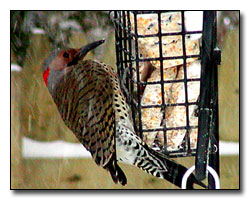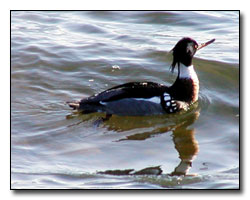|
Wildlife does not appear just because we've studied the Peterson's or Audubon Guides. Wildlife is always there... but sometimes we do not know how to see them. Are some people just lucky? If the birds know bird language and they understand what it means... won't you be able to see more of nature if you understood the universal bird language? By just learning the universal bird language, even from your
backyard, you will recognize base line of the birds and only then you will be able to recognize a change
 in the pattern and know what it means. You will see more and you will be able to see more wildlife.
in the pattern and know what it means. You will see more and you will be able to see more wildlife.
Baseline, once understood, is common sense combined with observational skills. Baseline is not doves flying up suddenly from the ground when you approach. Baseline is NOT when the birds stop singing their songs or stop feeding their young or stop male to male aggression or stop their companion calls. Baseline is when the birds do what is natural during the day and when they stop doing their natural behavior, they are out of baseline. And when they are not in baseline and they are giving the voice of alarm, all the wildlife within a certain radius knows. They listen and then they move on to safer areas depending on the bird language.
If you get really good at bird language, you will be capable of seeing those great wildlife moments while they are happening. If you choose to see wildlife, you will see them since you will be there at the right moment. For you, that little saying "A birdie told me", will become true when you see more wildlife.
Most people in the modern world do not understand and even hear what the birds are saying because they are always thinking of other things when they are walking in nature. Because of the modern day stress  and all the things that "Need to be done", most modern world people miss the most obvious things just because their mind is somewhere else. How many times do you drive to a destination and you don't even remember going down a certain road or taking a certain exit off the highway. "How did I get here? I don't even remember even the simplest turns and stops!" Now, take yourself into nature and keep that same mind set. How are you ever going to see wildlife? You will see some, but you will miss the very best ones. When you walk into nature thinking of other things, the birds pick up on your body language and react... most of the time unfavorably. Every one of your thoughts and movements while walking in nature relates to a nature opportunity. The reason some people are able to see wildlife and some people do not is due to body language. The birds always listen and see since they are always aware of survival. Once you become proficient in moving within nature, you will almost become invisible to the wildlife.
and all the things that "Need to be done", most modern world people miss the most obvious things just because their mind is somewhere else. How many times do you drive to a destination and you don't even remember going down a certain road or taking a certain exit off the highway. "How did I get here? I don't even remember even the simplest turns and stops!" Now, take yourself into nature and keep that same mind set. How are you ever going to see wildlife? You will see some, but you will miss the very best ones. When you walk into nature thinking of other things, the birds pick up on your body language and react... most of the time unfavorably. Every one of your thoughts and movements while walking in nature relates to a nature opportunity. The reason some people are able to see wildlife and some people do not is due to body language. The birds always listen and see since they are always aware of survival. Once you become proficient in moving within nature, you will almost become invisible to the wildlife.
Instinct is a very valuable asset. By using the language of the birds to enhance your intuitive instincts, you will be able to be in the right place at the right time. The more of the brain that we use to recognize baseline behaviors of the birds, the more that we will see. Reacting to your gut feelings and to your intuitions will enable you to see more of nature.
The Five Voices of the Birds:
1) Song
2) Companion Calls
3) Male To Male Aggression
4) Begging Calls
5) Voice of Alarm
The 5 voices are learned from the song birds such as the Robin, White-Throated Sparrow, Cardinal, Junco, Wren, Cat Bird and Thrushes. Since the song birds are ground feeders, they are the first to see and hear possible threats (including you approaching). If they feel threatened, the birds will sound the voice of alarm. By listening to the song birds and learning from them, you will be able to know the wildlife around you. Learn about the five voices of the birds.
| 
